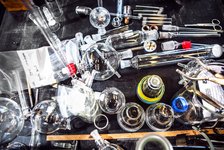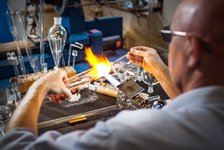
The following and other glass types are used in the glassblowing shop:
It might be possible to order other types of glass, depending on the task.

Most of the work is done hands-on using a propane/oxygen flame, reaching up to approx. 2500 degrees Celcius. The glass setups are formed by fixating the glass rod or glass tube and using the flame to mold the glass.
Large-scale assignments are made on a special lathe with a capacity of ø250 mm tubes and 20L flasks.
Glassblowing assignments include making glass setups for research and educational purposes, inventing new glass constructions, repairing existing glass setups, cutting of glass, cleansing of highly contaminated glass panes, as well as offering guidance and advice on glass and heat stability, acid/base resistance and pressure limits.
Examples of glass setups: